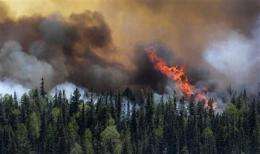Arizona blaze part of new era -- more big wildfires

(AP) -- The fires searing parts of the West are an eerie echo of the past, a frightening reminder of a once terrible danger that had been held largely at bay for decades.
The number of large wildfires has been rising for roughly the past 25 years, and they are lasting longer amid fire seasons that also last longer.
Is it global warming? Experts won't say that, pointing instead to a variety of factors ranging from local weather to insect infestations to more people living and camping out in the woods.
The Arizona fire, with almost half a million acres destroyed, makes it one of the largest since statehood in 1912. A related blaze is under way in New Mexico, another fire has forced people to evacuate parts of Colorado, and the National Weather Service has issued "red flag" warnings - indicating conditions favorable to wildfires - for parts of Texas, Florida and Alabama.
So far this year, 31,650 wildfires have burned more than 4 million acres of land - more than twice the area of Delaware - according to the National Interagency Coordination Center. That's up from 27,077 fires at the same time a year ago, which burned about a third as much acreage as this year.
The number of large fires began to grow in the mid-1980s, according to research by Anthony L. Westerling of the University of California, Merced. His paper published in the journal Science in 2006 documented the number, size and frequency of fires.
The fires in Yellowstone Park in 1988 seemed to inaugurate this new era of major wildfires in the West. These blazes lasted more than three months and burned 1.5 million acres of forest. Despite the investment of millions of dollars and deployment of 25,000 firefighters, they were only extinguished when snow began to fall in mid-September, Steven W. Running of the University of Montana said in a commentary on Westerling's study.
The increase in large wildfires could be seen as a return to the situation a century earlier, when they were more common.
The last of those big fires occurred during the drought in the 1930s, noted Stephen J. Pyne of Arizona State University, author of "Year of the Fires: The Story of the Great Fires of 1910." After that, a combination of fire-control efforts and social changes resulted in fewer fires.
Now, over the last few decades, there has been an increase, although not every year, said Pyne. "The question is why."
The U.S. Forest Service and U.S. Geological Survey studied fires of more than 1,000 acres and found that from 1984 to 1999 an average of 2.2 million acres nationally burned each year. From 2000 to 2008, the acreage destroyed annually rose to 6.4 million acres.
"What we can't do is definitively tie this to any specific driving factor like climate variability," said Matt Rollins, who monitors wildfires for the Geological Survey. That's because fire is a highly complex ecosystem process affected by local, short-term weather patterns, regional climate trends, vegetation and other elements like storm damage, insects and pathogens, along with human activities, Rollins explained.
Thomas W. Swetnam of the University of Arizona said frequent and extensive fires were common before 1900, and tree ring records show they occurred at the same times in many areas of the West.
"What's different about this (Arizona) fire is the severity, the intensity of the heat and the amount of trees that are killed," he said. It's at least partly because the lack of frequent surface fires allowed fuel like brush and leaves to accumulate over the years.
Add high temperatures and windy conditions and the scene is set for a devastating fire.
In the middle of the 1900s, "Smokey Bear and the government Park Service and Forest Service made it their mission to put all fires out," Swetnam said, and that "disrupted the natural fire regime."
Surface fires were the natural way to remove the kind of growth that's been building up for a century, he said.
Overgrazing, logging and fire prevention have created a lot more stuff to burn, added Pyne.
Global warming has also been predicted to result in more wildfires by producing more hot, dry conditions. But "we don't even need to involve global warming," in this case, Pyne said. It's hot at this time of year, and "all you need is couple of weeks of really dry weather."
In recent decades, the policy of attacking every fire changed and officials began trying to allow natural fires to flare up again, Pyne said. "That was the goal. We knew we could not continue to exclude fire; it was self-defeating."
In remote areas especially, fires have been allowed more room, he said, but the problem comes when that policy is taken over by sloppy campers, arsonists and lightning.
Changes in land use have also added to the problem, Pyne said. Cities and suburbs have expanded into fire-prone areas and new wilderness areas provide plenty of places for fires to concentrate.
Over a century ago, massive and deadly forest fires plagued America. The deadliest wildfire in American history killed an estimated 2,200 people and destroyed more than 2,400 square miles of forest around Peshtigo, Wis. But that blaze gets little attention because it occurred on the same day in 1871 as the "Great Chicago Fire," which killed 300 people a couple hundred miles to the south.
©2011 The Associated Press. All rights reserved. This material may not be published, broadcast, rewritten or redistributed.


















